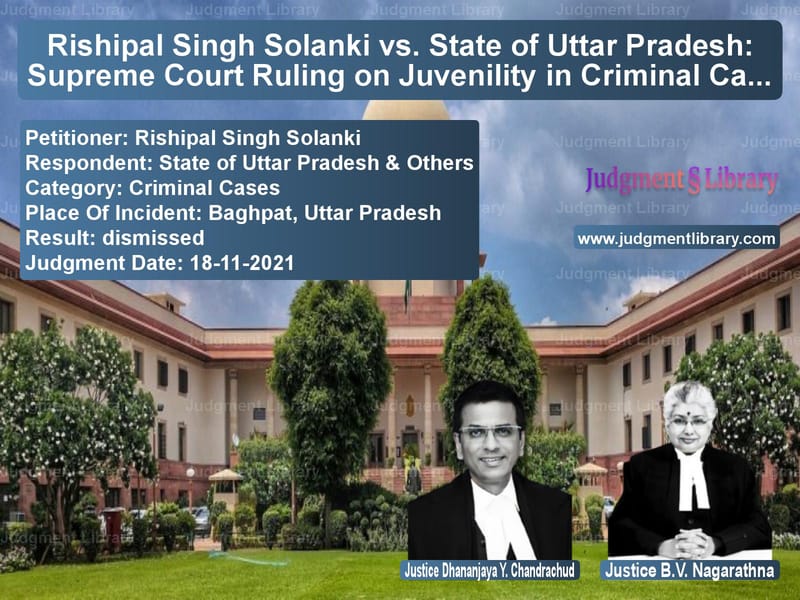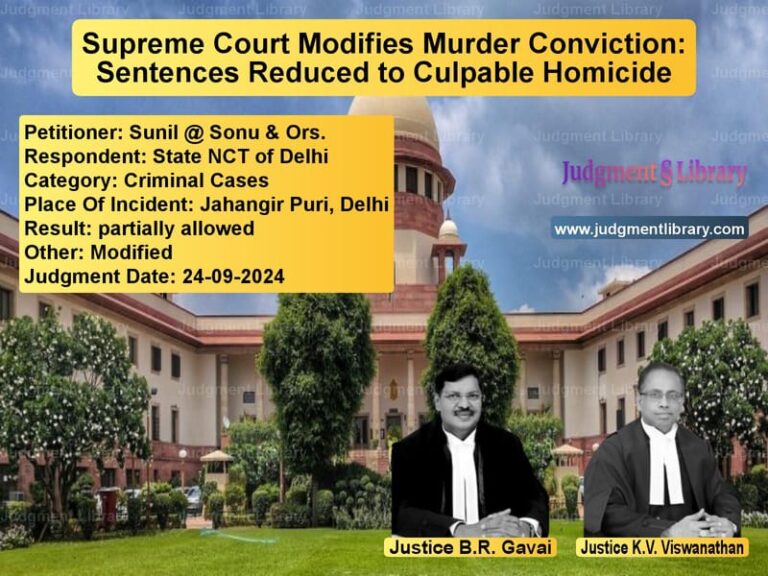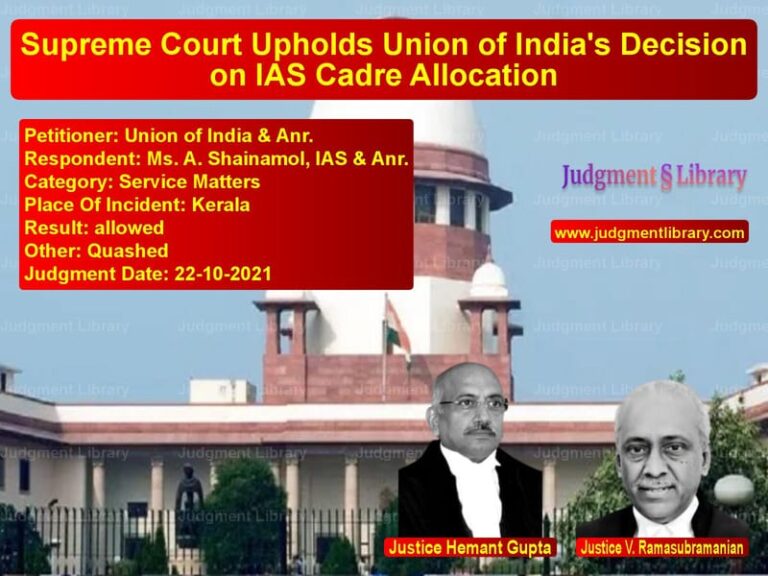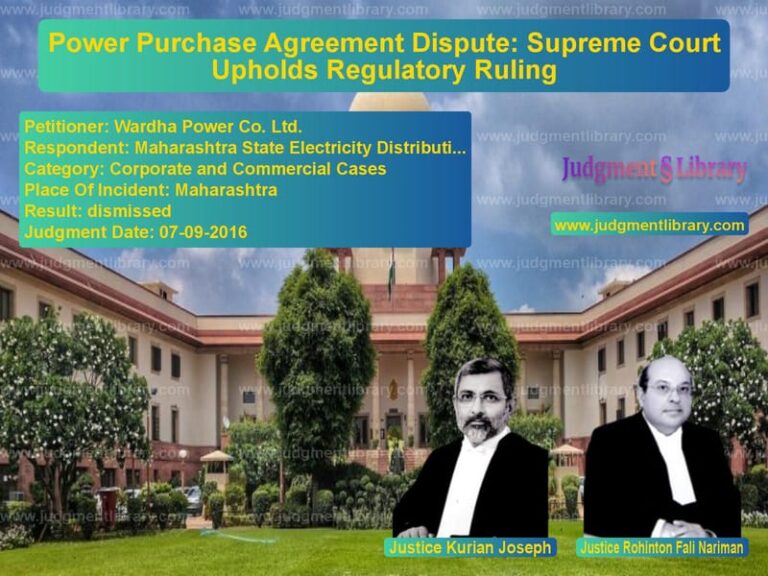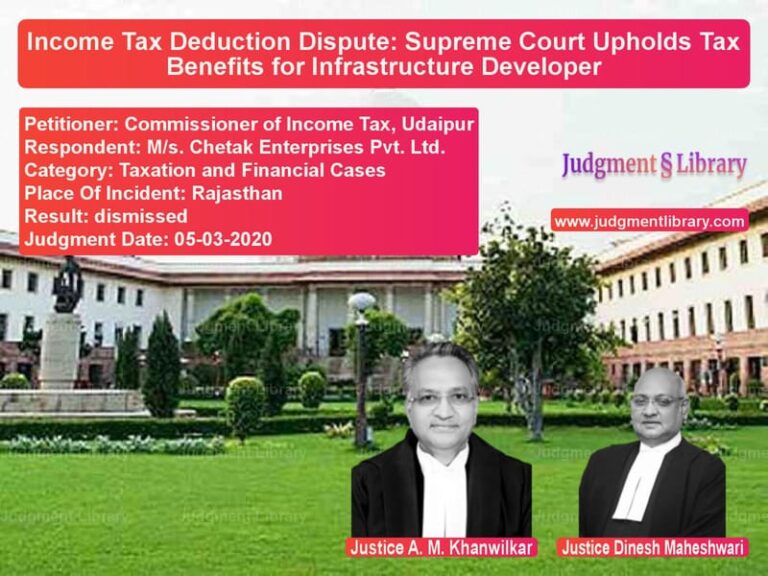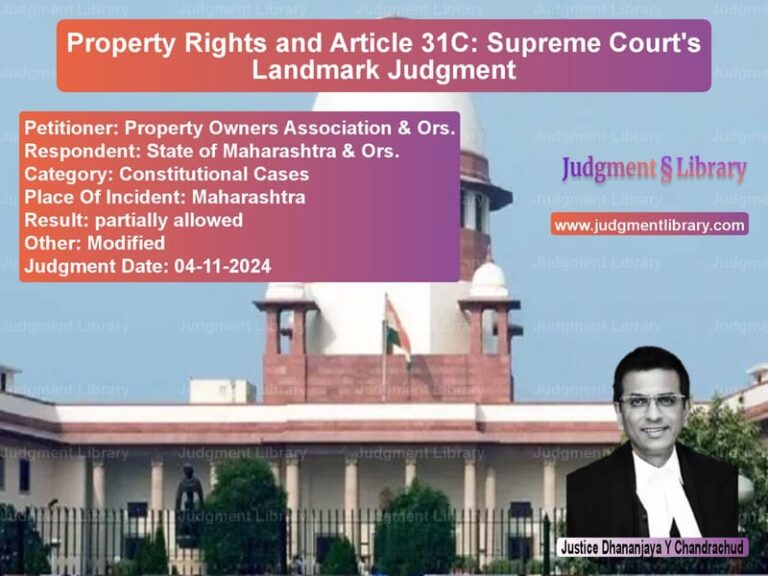Rishipal Singh Solanki vs. State of Uttar Pradesh: Supreme Court Ruling on Juvenility in Criminal Cases
The case of Rishipal Singh Solanki vs. State of Uttar Pradesh & Others revolves around the issue of juvenility under the Juvenile Justice (Care and Protection of Children) Act, 2015. The Supreme Court was tasked with determining whether the accused, Nishant Solanki, could be declared a juvenile based on his documents, and whether the High Court erred in upholding his status as a minor at the time of the offense.
Background of the Case
The case originated from an incident on 5th May 2020 in Baghpat, Uttar Pradesh, where the appellant, Rishipal Singh Solanki, and his family were attacked by a group of accused, including Nishant Solanki. The attack resulted in serious injuries and the death of the appellant’s father and uncle.
Following the incident, a case was registered under Sections 147, 148, 149, 323, 307, 302, and 34 of the Indian Penal Code (IPC). Nishant Solanki’s mother filed an application before the Juvenile Justice Board (JJ Board), Baghpat, seeking to declare him a juvenile. The JJ Board allowed the application, declaring Nishant a juvenile delinquent, which was subsequently upheld by the District Court and the High Court of Allahabad. Dissatisfied, the appellant challenged the High Court’s decision before the Supreme Court.
Arguments by the Petitioner (Rishipal Singh Solanki)
- The petitioner contended that Nishant’s claim of juvenility was fraudulent and based on fabricated documents.
- The signatures of Nishant in his school admission records from Class 1 and Class 8 were identical, raising doubts about the authenticity of the documents.
- The petitioner questioned how an Aadhaar number could be mentioned in school admission records from 2009 when Aadhaar was first issued in India in 2010.
- It was also argued that Nishant’s educational records showed inconsistencies, such as completing Class 1 at the age of four and reaching Class 8 in an unrealistically short span.
- The petitioner urged that an ossification test should be conducted to determine Nishant’s actual age.
Arguments by the Respondents (State of Uttar Pradesh & Nishant Solanki)
- The respondents contended that Nishant’s birth date, as recorded in his High School mark sheet, was 25th September 2004, making him 15 years and 8 months old at the time of the offense.
- The defense maintained that under Section 94 of the JJ Act, 2015, the matriculation certificate should be considered conclusive proof of age unless there is strong evidence to the contrary.
- They argued that an ossification test was not necessary, as the law prioritizes documentary evidence over medical tests.
- The defense cited multiple judgments emphasizing that in cases of doubt, the benefit should be given to the accused in determining juvenility.
Supreme Court’s Observations
The Supreme Court bench, comprising Dr. Dhananjaya Y. Chandrachud and B.V. Nagarathna, examined the principles governing the determination of juvenility under the JJ Act, 2015.
The Court made the following observations:
- Matriculation Certificate as Conclusive Proof: The JJ Act provides that a matriculation certificate is the primary document for determining age, followed by a birth certificate issued by municipal authorities, and only in their absence can a medical test be considered.
- Presumption of Juvenility: Section 94 of the JJ Act creates a presumption that a person is a juvenile if their documents confirm it, and such presumption can only be rebutted with strong contradictory evidence.
- Burden of Proof: The Court emphasized that the burden to disprove the validity of the birth certificate or school records lies on the party challenging them.
- Ossification Test as a Last Resort: The Court ruled that an ossification test should not be resorted to unless there is a lack of credible documentary evidence.
- Standard of Proof: The Court reaffirmed that a claim of juvenility can be raised at any stage, even post-conviction, and should be assessed liberally in borderline cases.
Key Judgments Cited
The Supreme Court relied on several precedents while delivering its judgment:
- Abuzar Hossain v. State of West Bengal (2012) 10 SCC 489: Held that a claim of juvenility could be raised at any stage of proceedings.
- Ashwani Kumar Saxena v. State of Madhya Pradesh (2012) 9 SCC 750: Ruled that the court should not conduct a roving inquiry behind the validity of birth certificates unless clear evidence of manipulation exists.
- Parag Bhati v. State of Uttar Pradesh (2016) 12 SCC 744: Stressed that while juvenility claims should be examined carefully, courts should avoid hyper-technical approaches.
- Babloo Pasi v. State of Jharkhand (2008) 13 SCC 133: Established that medical evidence is not conclusive for determining age.
Final Judgment
The Supreme Court upheld the High Court’s decision, confirming that:
- Nishant Solanki was a juvenile at the time of the offense based on his matriculation certificate.
- The petitioner failed to provide sufficient evidence to rebut the claim of juvenility.
- An ossification test was not required, given the availability of school records.
- The appeal was dismissed, affirming that Nishant would be treated as a juvenile under the JJ Act, 2015.
Impact of the Judgment
This ruling reinforces several critical principles:
- Strict Adherence to the JJ Act: Courts must prioritize documentary evidence over medical tests in determining age.
- Protection of Juveniles: The decision ensures that juveniles in conflict with the law receive protection under the JJ Act, regardless of the severity of the offense.
- Finality of Age Determination: The judgment sets a precedent that once a birth certificate or matriculation document is verified, the claim of juvenility cannot be easily contested.
- Ensuring Fairness in Criminal Law: By emphasizing the liberal approach to juvenility claims, the ruling prevents wrongful prosecution of minors as adults.
Conclusion
The Supreme Court’s ruling in Rishipal Singh Solanki vs. State of Uttar Pradesh is a landmark decision reaffirming the principle that juvenility claims must be determined based on documentary evidence rather than subjective assessment or medical tests. The judgment ensures that the protections under the JJ Act, 2015 are upheld while preventing misuse of the juvenility plea through fraudulent documentation.
Petitioner Name: Rishipal Singh Solanki.Respondent Name: State of Uttar Pradesh & Others.Judgment By: Justice Dhananjaya Y. Chandrachud, Justice B.V. Nagarathna.Place Of Incident: Baghpat, Uttar Pradesh.Judgment Date: 18-11-2021.
Don’t miss out on the full details! Download the complete judgment in PDF format below and gain valuable insights instantly!
Download Judgment: rishipal-singh-solan-vs-state-of-uttar-prade-supreme-court-of-india-judgment-dated-18-11-2021.pdf
Directly Download Judgment: Directly download this Judgment
See all petitions in Juvenile Justice
See all petitions in Bail and Anticipatory Bail
See all petitions in Murder Cases
See all petitions in Judgment by Dhananjaya Y Chandrachud
See all petitions in Judgment by B.V. Nagarathna
See all petitions in dismissed
See all petitions in supreme court of India judgments November 2021
See all petitions in 2021 judgments
See all posts in Criminal Cases Category
See all allowed petitions in Criminal Cases Category
See all Dismissed petitions in Criminal Cases Category
See all partially allowed petitions in Criminal Cases Category

